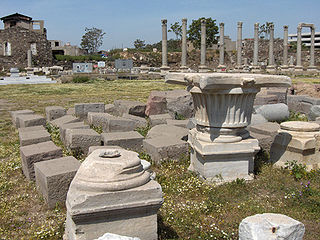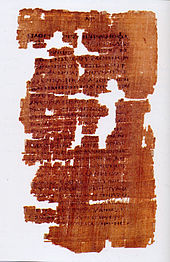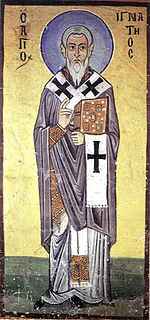
The Epistle to the Philippians, commonly referred to as Philippians, is a Pauline epistle of the New Testament of the Christian Bible. The epistle is attributed to Paul the Apostle and a co-author named Timothy, and is addressed to the Christian church in Philippi. Paul and Silas first visited Philippi in Greece during Paul's second missionary journey, which occurred between approximately 49 and 51 AD. Philippi was the location of the first Christian community established in Greece.
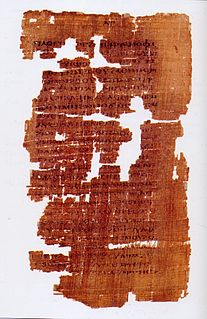
The Epistle of Barnabas is a Greek epistle written between 70–132 CE. It is preserved complete in the 4th-century Codex Sinaiticus, where it appears immediately after the New Testament and before the Shepherd of Hermas. For several centuries it was one of the "antilegomena" writings that some Christians looked on as sacred scripture, while others excluded them. Eusebius of Caesarea classified it as such. It is mentioned in a perhaps third-century list in the sixth-century Codex Claromontanus and in the later Stichometry of Nicephorus appended to the ninth-century Chronography of Nikephoros I of Constantinople. Some early Fathers of the Church ascribed it to the Barnabas who is mentioned in the Acts of the Apostles, but it is now generally attributed to an otherwise unknown early Christian teacher, perhaps of the same name. It is distinct from the Gospel of Barnabas.
The Apostolic Fathers were Christian theologians who lived in the 1st and 2nd centuries AD, who are believed to have personally known some of the Twelve Apostles, or to have been significantly influenced by them. Their writings, though popular in Early Christianity, were not included in the canon of the New Testament. Many of the writings derive from the same time period and geographical location as other works of early Christian literature which came to be part of the New Testament. Some of the writings found among the Apostolic Fathers appear to have been highly regarded as some of the writings which became the New Testament.

The New Testament apocrypha are a number of writings by early Christians that give accounts of Jesus and his teachings, the nature of God, or the teachings of his apostles and of their lives. Some of these writings have been cited as scripture by early Christians, but since the fifth century a widespread consensus has emerged limiting the New Testament to the 27 books of the modern canon. Roman Catholic, Eastern Orthodox and Protestant churches generally do not view these New Testament apocrypha as part of the Bible.

The pastoral epistles are three books of the canonical New Testament: the First Epistle to Timothy the Second Epistle to Timothy, and the Epistle to Titus. They are presented as letters from Paul the Apostle to Timothy and to Titus. They are generally discussed as a group and are given the title pastoral because they are addressed to individuals with pastoral oversight of churches and discuss issues of Christian living, doctrine and leadership. The term "pastorals" was popularized in 1703 by D. N. Berdot and in 1726 by Paul Anton.
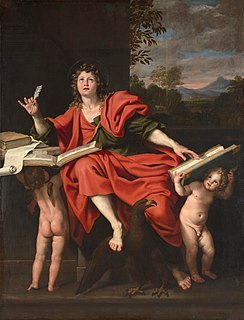
John the Presbyter was an obscure figure of the early Church who is either distinguished from or identified with the Apostle John and/or John of Patmos. He appears in fragments from the church father Papias of Hierapolis as one of the author's sources and is first unequivocally distinguished from the Apostle by Eusebius of Caesarea. He is frequently proposed by some as an alternative author of some of the Johannine books in the New Testament.
Martyrdom of Polycarp is a manuscript written in the form of a letter that relates the religious martyrdom of Polycarp, Bishop of Smyrna and disciple of John the Apostle in the 2nd century AD. It forms the earliest account of Christian martyrdom outside of the New Testament. The author of Martyrdom of Polycarp is unknown, but it has been attributed to members of the group of early Christian theologians known as the Church Fathers. The letter, sent from the church in Smyrna to another church in Asia Minor at Philomelium, is partly written from the point of view of an eye-witness, recounting the arrest of the elderly Polycarp, the Romans' attempt to execute him by fire, and subsequent miraculous events.
The Lost Books of the Bible and the Forgotten Books of Eden (1926) is a collection of 17th-century and 18th-century English translations of some Old Testament Pseudepigrapha and New Testament Apocrypha, some of which were assembled in the 1820s, and then republished with the current title in 1926.
The Letter to the Trallians by Ignatius, is an early-second-century Bishop of Antioch and martyr, was written to the church in Tralles during the bishop's transport from Antioch, Syria, to his execution in Rome. Trallians is one of seven epistles written by Ignatius to early centers of Christianity in Anatolia.

The First Epistle of Clement is a letter addressed to the Christians in the city of Corinth. The letter was composed at some time between AD 70 and AD 140, most likely around 96. It ranks with Didache as one of the earliest—if not the earliest—of extant Christian documents outside the canonical New Testament. As the name suggests, a Second Epistle of Clement is known, but this is a later work by a different author. Neither 1 nor 2 Clement are part of the canonical New Testament, but they are part of the Apostolic Fathers collection.

Christianity in the 2nd century was largely the time of the development of variant Christian teachings, and the Apostolic Fathers who are regarded as defenders of the developing proto-orthodoxy. Major figures who were later declared by the developing proto-orthodoxy to be heretics were Marcion, Valentinius, and Montanus.

The authorship of the Petrine epistles is an important question in biblical criticism, parallel to that of the authorship of the Pauline epistles, since scholars have long sought to determine who were the exact authors of the New Testament letters. Most scholars today conclude that Saint Peter was not the author of the two epistles that are attributed to him and that they were written by two different authors.

A biblical canon or canon of scripture is a set of texts which a particular religious community regards as authoritative scripture. The English word "canon" comes from the Greek κανών, meaning "rule" or "measuring stick". Christians became the first to use the term in reference to scripture, but Eugene Ulrich regards the idea as Jewish.

The canon of the New Testament is the set of books Christians regard as divinely inspired and constituting the New Testament of the Christian Bible. For most, it is an agreed-upon list of twenty-seven books that includes the Canonical Gospels, Acts, letters of the Apostles, and Revelation. The books of the canon of the New Testament were written before 120 AD.

The Church Fathers, Early Church Fathers, Christian Fathers, or Fathers of the Church were ancient and influential Christian theologians and writers. There is no definitive list. The era of these scholars who set the theological and scholarly foundations of Christianity largely ended by AD 700.
The Letter to the Romans by Ignatius, an early-second-century Bishop of Antioch, was written during his transport from Antioch, Syria, to his execution in Rome. One of seven extant epistles written by Ignatius, Romans is Ignatius’ most detailed explanation of his views on martyrdom.


